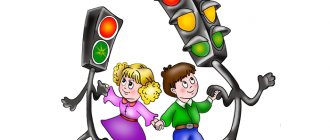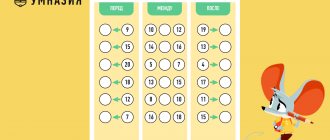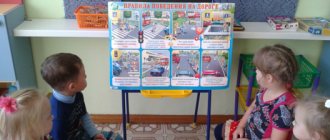Algorithm for working with preschool children to familiarize themselves with traffic rules
Denisova N.S. Algorithm for working with preschool children to familiarize themselves with the rules of the road // Sovushka. 2018. N3 (13). URL: https://kssovushka.ru/zhurnal/13/ (access date: 01/19/2022).
Order No. 116374
With the development of the technical process, the speed of movement and the density of traffic flows on the streets and roads of our country are growing exponentially. In this regard, the number of road traffic accidents is also increasing. The number of accidents involving children is also growing.
These road accidents are most often caused by children themselves. This is caused by ignorance of the basic principles of traffic rules and the indifferent attitude of adults towards the behavior of children on the roadway. Left to their own devices, children, especially younger ones, pay little attention to the dangers on the road. This is explained by the fact that children do not have the protective reaction to traffic conditions that is characteristic of adults. That's why they calmly run out onto the road in front of a moving car.
To protect a child from danger, you need to start preparing him for the street as early as possible, familiarize him with the rules of the road, road signs, teach him how to navigate in space, and develop his skills for behavior on the street and in transport. This will reduce the likelihood of road accidents.
The goal of preschool teachers is to create conditions in groups that optimally ensure the process of teaching preschoolers the rules of the road and developing in them the necessary skills and abilities, developing positive, sustainable habits of safe behavior on the street.
Tasks:
— developing skills for safe behavior on the roads in children through practical activities;
— consolidation of traffic rules and practical skills of behavior in the playing space;
— teaching children to apply their knowledge in specific situations;
— increasing the pedagogical literacy of parents on the issues of safe behavior of children on the roads.
Introducing children to the rules of safe behavior on the roads is based on the increasing degree of complexity of the work, starting with the elementary tasks of raising children of the first junior group and ending with more complex concepts that the children of the preparatory group must learn: after all, most of them will go to school on their own.
The tasks of preschool educational institutions for promoting safe behavior in preschoolers on the streets and roads of the city
| Junior preschool age | Middle preschool age | Senior preschool age |
| 1. Introduce children to transport typical for our area (trucks and cars, city transport, special purpose vehicles). | 1. Learn to navigate indoors, the kindergarten area and the surrounding area | 1. Systematization of children’s knowledge about the structure of the street, about road traffic, familiarization with the concepts of “square”, “boulevard”, “prospect”. |
| 2. Introduce the concepts of “street”, “traffic light”, “road” | 2. Continue to introduce traffic rules, traffic signs “Pedestrian crossing”, “Public transport stop”. | 2. Continue to introduce road signs - warning, prohibiting, informational. |
| 3. Teach children to transfer to games impressions received at walk. Familiarize yourself with the driver's work. | 3. Continue to introduce the concepts of “street”, “traffic light”, “road”, “intersection”, “stop” | 3. Awareness of the need to follow traffic rules and familiarize with the consequences of an accident |
| 4, Teach children to distinguish road traffic part of the road, sidewalk, shoulder, understand the meaning of green and red traffic light. | 4. Expand children’s knowledge about public and special transport and its purpose. | 4. Develop the ability to navigate within the neighborhood closest to the kindergarten (ability to find the way home from kindergarten). |
| 5. Form initial ideas about safe behavior on the road | 5.Develop skills of cultural behavior in public transport. | 5. To develop independence and responsibility in actions related to crossing streets. |
The success of forming a conscious understanding of preschoolers’ own safety is impossible without the interaction of all participants in educational relations (teacher – child – parent – preschool educational institution specialist). In this regard, there was a need to create an effective system for working with children to promote life safety, as well as to develop the child’s competence in such a way that he was ready to independently solve problems related to preserving his health and his life.
First, we developed a work algorithm consisting of three directions
| directions |
“Formation of theoretical ideas about traffic rules in children” “Creating a subject-developing environment” |
“Development of practical skills and traffic rules in children” |
“Application of acquired skills in free play and independent activities by children” |
| TEACHERS |
5. Preparation of routes for bladeless movement around the microdistrict. |
| 1. Production of signs “Rules of conduct on the road”; 2. Organization of game situations to implement children’s previously acquired knowledge; |
| PUPILS |
| ||
| PARENTS OF PARENTS |
|
The areas of work correspond to the participants in the educational process: teachers, students, parents (legal representatives) of students.
The algorithm was created to determine the amount of work in all areas, taking into account the requirements of the program for the formation of knowledge, skills and abilities of preschool children, as well as the requirements for the conditions for the implementation of the Main Educational Program of the MBDOU “Kindergarten No. 15”.
As part of the work on the created algorithm, activities were developed and carried out.
Thus, we have developed a series of parent meetings to work with parents:
1. Meeting
Agenda:
- Familiarization and approval of the plan for interaction with parents to teach children the rules of the road.
- Data from the Traffic Police Department of the Sarov Internal Affairs Directorate. Voiced by a traffic police officer.
- Causes of road accidents involving children. Age characteristics of children.
- General recommendations for parents on observing traffic rules according to the age of their children.
- Recommendations for parents on the use of literary words and educational games on traffic rules.
2. Meeting
Agenda:
- Results of work for the first quarter on traffic rules.
- Consultation “Features of safe behavior in winter.” Demonstration of photographs of traffic violations by pedestrians and discussion of them.
- Involving parents in organizing a subject-development environment according to traffic rules. Introduce parents to an exhibition of posters, drawings, and crafts made together with parents, children and teachers.
- Awarding certificates to active participants in events held at preschool educational institutions on traffic rules.
3. Meeting
Agenda:
- Results of work for the second quarter.
- Game-training with parents “Instilling skills of safe behavior on the street.” (How to use a walk to instill in your child the skills of safe behavior on the street, practicing the route “My way to kindergarten”). Organizing an excursion jointly between parents and children around the city “Such different cars.”
- Preparation for the Open Day “The traffic light welcomes guests” (discussion): holidays with the participation of traffic police officers, children, parents, teachers “Celebration of our street”; exhibition of drawings and crafts “Our friend Traffic Light”; exhibition of photographic materials of children and parents “On the streets of the beloved city”; Schedule of open classes on traffic rules.
4. Meeting
Agenda:
- Results of work for the academic year. Results of the survey.
- Plan of work with children for the summer - health period in kindergarten. Consultation for parents for the summer period “You, the child, transport and the road.”
- Final lesson jointly with children, teachers, and traffic police inspectors “What have we learned in a year.”
Work with parents: organizing general meetings of parents on issues of ensuring safety, improving and maintaining security, anti-terrorist protection of preschool educational institutions, instilling vigilance, responsibility for personal and collective safety in children; organizing parental participation in ensuring safety and providing assistance to preschool educational institutions; increasing the interest of the parent community in improving the technical equipment of preschool educational institutions; involving the parent community in participating in quality control of educational services.
Organization of interaction with security authorities (Internal Affairs Directorate, Department of Emergency Situations, OGPS, State Traffic Safety Inspectorate) and local government authorities: coordination of measures to inspect the buildings and territory of preschool educational institutions for their explosion safety using specialists from engineering services; distribution of responsibility for the safety of preschool educational institutions between departments; information exchange; joint development and coordination of security plans.
To instill safe behavior in preschoolers on the streets and roads of the city, various types of activities are carried out in kindergartens: educational and research (classes, observations, excursions, didactic games, experiments, experiments), gaming (thematic - role-playing, outdoor and didactic games), visual (drawing, applique, modeling). In addition, we decided to introduce into the educational process an annual open day “Unified Safety Day”, the content of which includes the following activities: celebration, drawing and collage making, a master class for parents of students, story games for students and their parents on the playground "Crossroads". An innovative approach to this problem helps our team strengthen the connection between the preschool institution and the traffic police officers and solve the main objective of the program: to instill in children sustainable safe behavior skills in any traffic situation, to promote the formation of skills to positively resolve the problem that has arisen.
To resolve issues about the sufficient competence of all participants in the educational process: teachers, students and parents, the necessary conditions have been created at MBDOU:
Game "Town"
- in the transition to the pool, a “Town” playroom has been organized, where teachers conduct conversations and practical exercises with children;
MBDOU premises
- in order to enrich the developmental environment, the methodological corner of the kindergarten is equipped with instructional material, methodological and children's literature, posters, recommendations, notes, scripts, materials covering the work experience of MBDOU teachers, interaction with the parent and the traffic police on the basics of safety and life in road traffic;
- In the interior of the kindergarten, signs “Rules for movement in the kindergarten building” are used.
- The art teacher organizes competitions with children for the best drawing on the topics: “Caution – the road!”, “Beware of the car!”, “We are pedestrians!”. The best drawings of children are exhibited in the foyer of the kindergarten;
- the music director, together with the physical education instructor, conducts physical education and recreational activities with children;
Group rooms
- Each MBDOU group has a traffic corner, where visual and demonstration material is widely presented,
- tabletop models of streets, attributes and manuals for materials were made, where children with a teacher can practice the acquired knowledge on this issue;
- Group teachers use bits (cards) according to the method of G. Doman.
Game room "Crossroads" on the territory of MBDOU
- On the territory of the kindergarten there are traffic markings, where teachers, using external road signs and house models, help children master the road alphabet.
The kindergarten has also developed a program for interaction between preschool specialists to prevent child injuries:
| Administration | Educational psychologist | Educators | Musical director. | FC instructor | Family |
| creation of a regulatory framework | promoting the formation of an emotionally favorable microclimate | implementation of an educational program to educate children about safe behavior on the street and roads | promoting the realization in creative activities of impressions and knowledge about safety on the street and road | promoting the development of physical qualities of children | developing safe behavior skills on the street and road |
| analysis of the state of work on the prevention of road injuries and development priority measures to improve it | assistance individual work with children to develop a style of behavior in traffic situations | creating conditions in a subject-developmental environment for groups to familiarize children with traffic rules | development of mobility of nervous processes | education by example disciplined pedestrians | |
| providing conditions for implementation of the educational program | promoting the formation of arbitrariness of the child’s emotional-volitional sphere | ||||
| monitoring the implementation of an educational program for the prevention of road injuries |
Forms and methods of differentiated preventive work to prevent DDTT.
1. With the teaching staff. For teachers, informational, practical and training sessions, a literature review, pedagogical advice, questionnaires, testing, and consultations were conducted. Teachers worked on the production of visual aids and games, exhibitions, and master classes. In the current academic year, the following events were held: Pedagogical Council “Kindergarten as a means of forming the foundations for the safety of one’s own life”; Consultations: “What should a teacher know about traffic rules?”, “Organization of work with preschoolers on traffic rules”; Master – class of direct educational activities with children of the senior group “We are pedestrians”; Review-competition “Equipping safety corners”.
2. With children. In our kindergarten, education is carried out: firstly, through direct perception of the road environment during targeted walks, where children observe the movement of vehicles and pedestrians, road signs, pedestrian crossings, etc.; In our work we use different techniques and methods:
Foresight of danger: We develop the ability to foresee danger and the skills of correct orientation in the road environment in preschoolers from a very early age. We structure this work so that children constantly practice acquiring three groups of skills: sensory, mental and motor. For example, in the process of observing a road at an intersection, we instill in children the ability to analyze, speak out loud thoughts about how dangerous a given situation is and what safe actions need to be taken.
Another example, you can show the picture “The boy dropped his mitten on the roadway.” Children must answer what he should do in this situation. Answer: ask adults to lift the mitten. You should not do this yourself, as he may be run over by a vehicle, the drivers of which may not notice a small child who is also bending down to pick up the mitten.
Formation of skills of an eye for traffic movement. Our children experienced particular difficulties in determining the distance and speed of moving vehicles and, therefore, did not understand whether the car was close or far away, which in turn could cause an accident. To learn how to determine the distance to an approaching car, we carried out the following work: we previously agreed from what place (we determined a landmark) the children were following the car in order to determine whether it was moving quickly or slowly. Then we chose a good place for observation and, at my signal, “spotted” the desired car, which was driving in our direction, and began to count together until the car approached the place where the children were standing. By comparing several such counts (one car on the count of 10, another faster, on the count of 8, a bus on the count of 12), children begin to understand that vehicles have different speeds, gain experience, and develop an eye and a sense of time when assessing the movement of vehicles. . They clearly see that transport is moving much faster than it seems. Therefore, a child cannot cross the road on his own, without adults.
And also, in the process of observing the movement of transport, we drew the children’s attention to the fact that a motorcycle or a passenger car can drive behind a large vehicle at a higher speed. The danger of the situation is that a small car or motorcycle is not visible; they are obscured, for example, by a bus. In turn, the driver of a car (motorcycle) also does not see a pedestrian if he crosses the road in a place where visibility is blocked. As a result, collisions occur. For clarity, they showed a picture where a girl was crossing the road and did not see cars behind a large bus.
secondly, in the process of special developmental and training sessions on road topics. Such classes are held 1-2 times a week, didactic classes have the following topics: “The road to a preschool institution. Dangerous places in the area adjacent to a preschool institution”, “Foreseeing danger on the streets. Rules of behavior on the sidewalk, in the yard”, “Types of vehicles. Road signs for pedestrians”, “Being on the street with adults. Rules for crossing the roadway. Dangerous and safe actions of pedestrians and passengers. Pedestrian crossing (ground zebra crossing). In addition, employees of the State Traffic Inspectorate are invited to classes on road topics to supplement and explain to children certain provisions of the rules of safe behavior on the streets and roads.
We also use other methods and techniques. A game. During the game, the teacher enriches the children’s experience with a variety of sensory impressions, which contributes to the development of interest in the road environment, means of transportation, and rules of behavior. At the same time, attention must be paid to dangerous and safe places on the streets and roads.
Board games. Board games use models of road signs, traffic lights, figures of pedestrians, etc., with the help of which children perform certain actions or move pieces around the playing field.
Motor games or simulation of traffic situations. Some games develop hand motor skills, others develop motor coordination. In them, children imagine that they are standing on the sidewalk and are about to cross to the opposite side of the road at a zebra crossing. They make turns left, right, left again, walk, reach the middle, make a right turn, inspect the road from all sides and continue moving to the end. Motor play can also be used to explain to children why a car cannot stop immediately if a pedestrian or any obstacle appears in its path.
A game is organized with children when one child runs and the other gets in his way. As a result, the first child does not expect the appearance of the other and continues to move by inertia. Children see that moving objects cannot stop immediately. A car is a technical device. When braking, the driver tries to stop it, but for some time continues to move according to the law of inertia.
Special methods and techniques include presentations. The presentation contains a figurative type of information that is understandable to preschoolers; Forms a system for preventing road traffic injuries in children. The saying “it’s better to see once than to hear a hundred times” primarily applies to a small child. It is he, with his visual-imaginative thinking, who understands only that it is possible to simultaneously view, hear, act or evaluate the action of an object. That is why, when teaching preschoolers, we turned to those channels for obtaining information that are open. During our activities, we developed presentations (10 pcs.) to accompany classes and routine processes.
3. With parents of students
When organizing such important work to prevent child road traffic injuries, it is impossible not to involve the parents of students in it. We organize joint participation in events:
- general parent meetings to discuss issues of road traffic injuries;
- seminars on road safety issues, where parents study methods, forms, and means of teaching children the basics of road safety;
- holidays: “Visiting the Traffic Light”, “Best Pedestrian”, “Green, Yellow, Red”, “At a Forest Crossroads”, “Journey to the Land of Road Dating”;
- master class, leisure activities, KVN, round table, project activities, individual conversations, surveys.
All activities of the teaching staff in this area are clearly
planned taking into account the age and psychological characteristics of the pupils, fiction literature for preschoolers and methodological literature for educators, recommendations for parents were selected and systematized.
The effectiveness of ongoing activities in the following areas:
With the teaching staff
- The experience on the topic: “Formation of the foundations of safe behavior for children of senior preschool age” (teacher Yu.S. Chesnova) is summarized.
- A card file of games for preschoolers to teach children traffic rules has been developed; lesson notes on developing knowledge of traffic rules using ICT; Methodological recommendations for developing ideas about traffic rules among students; routes for safe movement around the neighborhood; master class: “Emergencies – what are they?”;
- Floor models of the “Kindergarten Microdistrict” were made.






